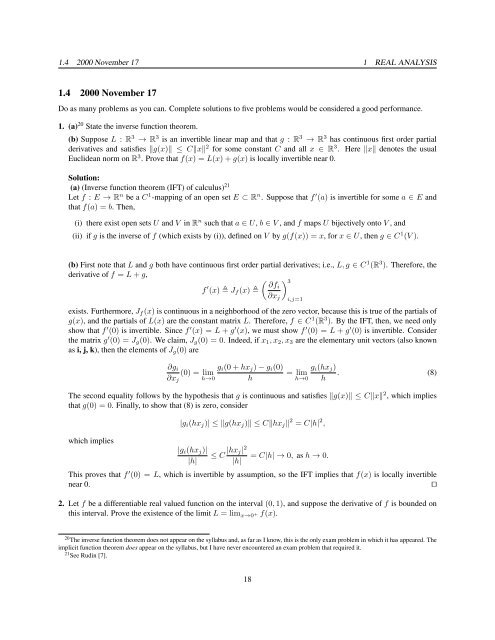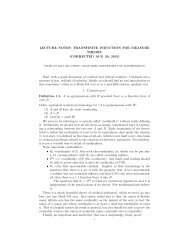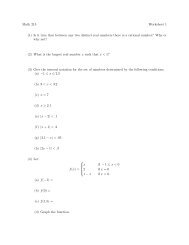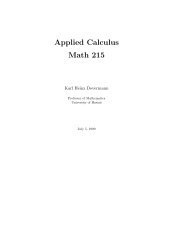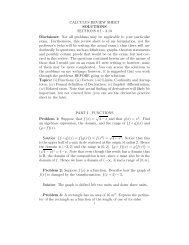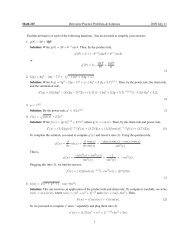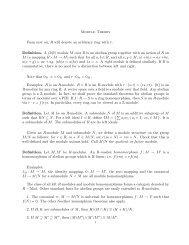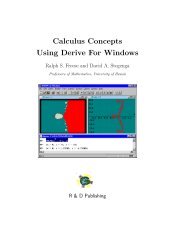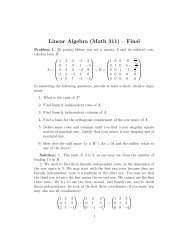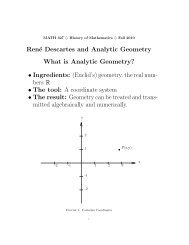Problems and Solutions in - Mathematics - University of Hawaii
Problems and Solutions in - Mathematics - University of Hawaii
Problems and Solutions in - Mathematics - University of Hawaii
You also want an ePaper? Increase the reach of your titles
YUMPU automatically turns print PDFs into web optimized ePapers that Google loves.
1.4 2000 November 17 1 REAL ANALYSIS<br />
1.4 2000 November 17<br />
Do as many problems as you can. Complete solutions to five problems would be considered a good performance.<br />
1. (a) 20 State the <strong>in</strong>verse function theorem.<br />
(b) Suppose L : R 3 → R 3 is an <strong>in</strong>vertible l<strong>in</strong>ear map <strong>and</strong> that g : R 3 → R 3 has cont<strong>in</strong>uous first order partial<br />
derivatives <strong>and</strong> satisfies g(x) ≤ Cx 2 for some constant C <strong>and</strong> all x ∈ R 3 . Here x denotes the usual<br />
Euclidean norm on R 3 . Prove that f(x) = L(x) + g(x) is locally <strong>in</strong>vertible near 0.<br />
Solution:<br />
(a) (Inverse function theorem (IFT) <strong>of</strong> calculus) 21<br />
Let f : E → R n be a C 1 -mapp<strong>in</strong>g <strong>of</strong> an open set E ⊂ R n . Suppose that f ′ (a) is <strong>in</strong>vertible for some a ∈ E <strong>and</strong><br />
that f(a) = b. Then,<br />
(i) there exist open sets U <strong>and</strong> V <strong>in</strong> R n such that a ∈ U, b ∈ V , <strong>and</strong> f maps U bijectively onto V , <strong>and</strong><br />
(ii) if g is the <strong>in</strong>verse <strong>of</strong> f (which exists by (i)), def<strong>in</strong>ed on V by g(f(x)) = x, for x ∈ U, then g ∈ C 1 (V ).<br />
(b) First note that L <strong>and</strong> g both have cont<strong>in</strong>uous first order partial derivatives; i.e., L, g ∈ C 1 (R 3 ). Therefore, the<br />
derivative <strong>of</strong> f = L + g,<br />
f ′ <br />
∂fi<br />
(x) Jf (x) <br />
∂xj<br />
exists. Furthermore, Jf (x) is cont<strong>in</strong>uous <strong>in</strong> a neighborhood <strong>of</strong> the zero vector, because this is true <strong>of</strong> the partials <strong>of</strong><br />
g(x), <strong>and</strong> the partials <strong>of</strong> L(x) are the constant matrix L. Therefore, f ∈ C 1 (R 3 ). By the IFT, then, we need only<br />
show that f ′ (0) is <strong>in</strong>vertible. S<strong>in</strong>ce f ′ (x) = L + g ′ (x), we must show f ′ (0) = L + g ′ (0) is <strong>in</strong>vertible. Consider<br />
the matrix g ′ (0) = Jg(0). We claim, Jg(0) = 0. Indeed, if x1, x2, x3 are the elementary unit vectors (also known<br />
as i, j, k), then the elements <strong>of</strong> Jg(0) are<br />
∂gi<br />
∂xj<br />
3<br />
i,j=1<br />
gi(0 + hxj) − gi(0)<br />
(0) = lim<br />
= lim<br />
h→0 h<br />
h→0<br />
gi(hxj)<br />
. (8)<br />
h<br />
The second equality follows by the hypothesis that g is cont<strong>in</strong>uous <strong>and</strong> satisfies g(x) ≤ Cx 2 , which implies<br />
that g(0) = 0. F<strong>in</strong>ally, to show that (8) is zero, consider<br />
which implies<br />
|gi(hxj)| ≤ g(hxj) ≤ Chxj 2 = C|h| 2 ,<br />
|gi(hxj)|<br />
|h|<br />
2 |hxj|<br />
≤ C = C|h| → 0, as h → 0.<br />
|h|<br />
This proves that f ′ (0) = L, which is <strong>in</strong>vertible by assumption, so the IFT implies that f(x) is locally <strong>in</strong>vertible<br />
near 0. ⊓⊔<br />
2. Let f be a differentiable real valued function on the <strong>in</strong>terval (0, 1), <strong>and</strong> suppose the derivative <strong>of</strong> f is bounded on<br />
this <strong>in</strong>terval. Prove the existence <strong>of</strong> the limit L = lim x→0 + f(x).<br />
20 The <strong>in</strong>verse function theorem does not appear on the syllabus <strong>and</strong>, as far as I know, this is the only exam problem <strong>in</strong> which it has appeared. The<br />
implicit function theorem does appear on the syllabus, but I have never encountered an exam problem that required it.<br />
21 See Rud<strong>in</strong> [7].<br />
18


